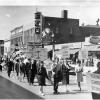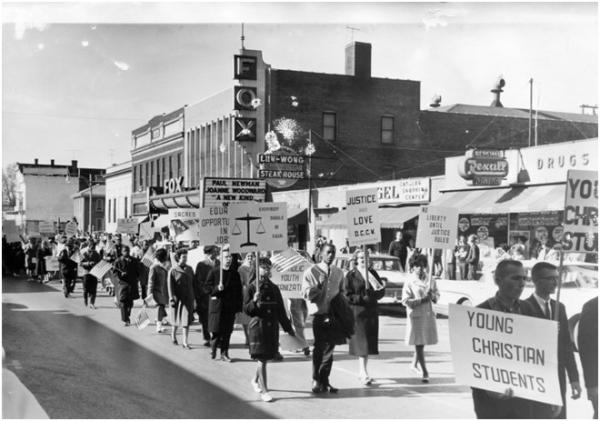Protests During the Civil Rights Movement
| Grade | 5th Grade | Class | Length of Lesson | 1 day |
| Lesson Title | Protests During the Civil Rights Movement |
| Unit Title | |
| Unit Compelling Question | How did the Civil Rights Movement impact American history? |
| Historical Context: 2018.012.003 This photograph, in the collection of the African American Museum of Iowa, shows a protest march that occurred in Fort Madison, Iowa in 1963. On November 2, 1963, 300 people gathered at Central Park in Fort Madison, Iowa for a protest march. Led by local NAACP president Joseph Dulin and author John Howard Griffin, the march was the first day of a two-day event which concluded with a Human Rights Rally. Dulin stated, "[the march] shall serve as a reminder that here, too, we do have problems that need correcting, and the Freedom March is to stress meaningful Civil Rights legislation." Organizations represented included the NAACP and the Catholic Interracial Council of Davenport. The following day, 900 people attended the rally where speakers included John Howard Griffin, who discussed his book, Black Like Me, and Dr. Harry Harper, who spoke about the history of race relations in Fort Madison. ~Matthew Miller, Teaching Iowa History Team ### The Civil War ended slavery but it did not bring African-Americans into full and equal participation in American society. While "Jim Crow" laws established legalized segregation across much of the South, the North also discriminated, sometimes through laws but sometimes in practice. Blacks in Iowa established local chapters organizations like the National Association for the Advancement of Colored People and sometimes mobilized black churches to promote equal rights. Even though Iowa law prohibited segregation in public accommodations like hotels, transportation, and restaurants, blacks were often barred or given sub-standard service. Simon Estes growing up in Centerville remembers that their movie theater required him to sit in the balcony. Others recall downtown Des Moines theaters adopted the same practice. Black veterans returning from WW II successfully pressured the University of Iowa to allow them to live in university dormitories. Until then, black students had to find private housing. In 1948, Edna Griffin and two other Des Moines blacks took Katz Drug to court for its refusal to serve them ice cream at its lunch counter. They won their case (and a very small penalty) and Katz opened its food service to all. A Cedar Rapids physician had to pressure local authorities until he was allowed to buy a house in a formerly all-white neighborhood. During the Civil Rights marches of the 1960s, local groups echoed their own demands for equal treatment. In 1965, Governor Harold Hughes appointed Iowa's first Equal Rights Commission to explore and investigate instances of discrimination. That same year, Iowa NAACP chapters joined with black churches to support Civil Rights efforts in the South. On March 7, local Des Moines blacks formed a march from the Capitol to downtown in support of the Selma to Montgomery marches. The efforts across the South captured the attention of the national news media, but Iowa efforts reflected a demand for equality here as well. |
|
| Lesson Supporting Question | |
| Lesson Overview | The lesson will be a part of a unit on the Civil Rights Movement in the 1960’s. The lesson will focus on the different methods of protest of those in support of equal rights. |
| Primary Sources Used |
|
| Resources Needed | |
| Standard | |
| Lesson Target | Students will understand how different groups protested during the CRM;Students will understand the advantages and disadvantages to each method of protest.;Students will understand how those opposed to the CRM responded to each method of protest |
| Lesson Themes | Civil Rights, Lawmaking, African American Experience |
|
| Formative Assessment (How will you use the formative assessments to monitor and inform instruction?) |
Students will do a think-pair-share where they will share their thoughts with their peers., Self-assessment: thumbs up/thumbs down. I will ask students how well they understand the material and ask them to give me thumbs up/thumbs down or thumbs to the side. This is a quick way for them to self-assess and for me to figure out who gets it and who needs more instruction |
| Summative Assessment (How does the lesson connect to planned summative assessment(s)?) |
The assessment for this lesson will be a writing prompt in which they write which method of protest is the most and least effective and give evidence and reasoning as to why they think that (Performance task). This assignment is not so much that they remember all the content, but that they can demonstrate argumentative writing and provide valid reasoning for their thoughts. |
| Author | Anjali Patel | Created | Last Edited | ||||
| Reviewer: Dr. Lisa Millsaps, University of Northern Iowa | |||||||
| Lesson Plan Development Notes: Teaching Methods, University of Northern Iowa, Fall 2018 | |||||||


